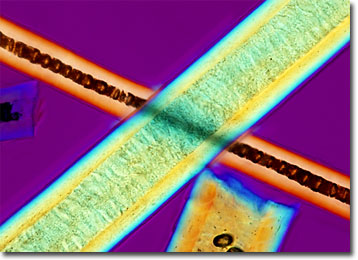Polarized Light Microscopy Digital Image Gallery
Badger Hair
Members of the weasel family Mustelidae, badgers are primarily nocturnal animals that are well known for their impressive digging capabilities. The eight different species of badgers vary in several respects, but all exhibit strong jaws and sharp, hefty claws on their forefeet, which can make them formidable to their enemies.

Most badgers are carnivores that predominantly feed upon rodents and other small animals, but some, such as the Eurasian badger Meles meles, are omnivorous. Also known as the true badger, Meles meles tends to live in bands, which share vast complexes of burrows. The American badger Taxidea taxus, on the other hand, is typically a solitary creature. Generally found in the dry lands characteristic of the western United States, this species does not often exceed 25 pounds and hibernates during the winter.
Badgers have been hunted by man for their pelts for many years, and their hair is utilized for a variety of products, but primarily for shaving brushes. It has not always been easy, however, for humans to catch the fast moving animals that can speedily disappear into their underground burrows and tunnels. Thus, to help solve this problem, the Germans developed a special breed of dog that would be able to expediently pursue badgers into tight spaces. Short, long-bodied, and energetic, these dogs came to be known as dachshunds, which is German for “badger dogs.”
